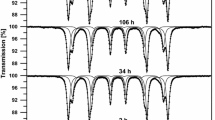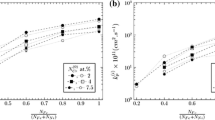Abstract
The following anomalies are theoretically analyzed: weakening of the protective ability of dense Cr2O3 film during its long-term thermal exposure (because of iron oxidation under the film); lowering of the heat resistance of Fe–Cr and Fe–Ni–Cr alloys during the oxidation (≥800°C) with an increase in the chromium content over 40 at. %; improving of the protective ability of the films formed at Fe–Ni alloys because of nickel oxidation under the dense FeO film; and the internal oxidation of the Fe ≤ 30Ni alloys under the FeO films with the internal formation of FeO oxides and spinel of NiFe2O4 type. It is shown that these anomalies can be explained, and the composition of the most heat-resistant alloys calculated, if one takes into account that associates with significantly stronger interatomic bonds than those in ideal solutions can form in solid solutions and cause unlimited solubility of the metallic components in each other.
Similar content being viewed by others
REFERENCES
Mrowec, S. and Werber, T., Nowoczene materially zaroodporne, Warszawa, 1982.
Gardiner, D.J., Gardiner, C., Littleton, C.J., et al., Oxid. Metals, 1987, vol. 27,nos. 1/2, p. 57.
Whittle, D.P. and Wood, G.C., J. Electrochem. Soc., 1968, vol. 115,no. 2, p. 133.
Tjong, S.C., Mater. Charact., 1991, vol. 26,no. 1, p. 296.
Benard, J., Oxidation des Metaux, vol. 2, Paris: Gauthiers-Villars, 1967, p. 141.
Hauffe, K., Reakzionen in und an festen Stoffen, Berlin: Springer, 1955.
Wood, G., Hodgkiess, T., and Whittle, D., Corros. Sci., 1966, vol. 6,nos. 3/4, p. 129.
Wood, G.C. and Whittle, D.P., Corros. Sci., 1967, vol. 7,no. 7, p. 763.
Hajduga, M. and Kucera, J., Oxid. Metals, 1988, vol. 29,nos. 1/2, p. 121.
Birks, N. and Meier, G.H., Introduction to High Temperature Oxidation of Metals, Pittsburgh: Edward Arnold, 1983.
Svechnikov, V.N., Zh. Tekh. Fiz., 1941, vol. 11,nos. 13–14, p. 687.
Svechnikov, V.N., Zh. Tekh. Fiz., 1948, vol. 18,no. 5, p. 679.
Grigorovich, V.K., Zharoprochnost' i diagrammy sostoyaniya (The Heat-Resistance and Phase Diagrams), Moscow: Metallurgiya, 1969.
Rakoch, A.G., Opara, B.K., Shabanova, I.P., et al., Zashch. Met., 1989, vol. 30,no. 3, p. 372.
Rakoch, A.G., Opara, B.K., Makarov, U.M., et al., Sbornik rabot po khimii (Collection of Works in Chemistry), no. 11, Alma-Ata: Izd. Kazan. Gos. Univ., 1988, p. 83.
Smeltzer, W., Trans. Canad. Inst. Met. Min., 1962, vol. 65, p. 366.
Diagrammy sostoyaniya dvoinykh metallicheskikh sistem (The Phase Diagrams of Binary Metal Systems), vol. 2, Lyakishev, N.P., Ed., Moscow: Mashinostroenie, 1997.
Author information
Authors and Affiliations
Rights and permissions
About this article
Cite this article
Khokhlov, V.V., Rakoch, A.G., Dement'eva, E.S. et al. Theoretical Analysis of Anomalies in High-Temperature Oxidation of Fe–Cr, Fe–Ni, and Fe–Ni–Cr Alloys. Protection of Metals 40, 62–66 (2004). https://doi.org/10.1023/B:PROM.0000013114.40128.50
Issue Date:
DOI: https://doi.org/10.1023/B:PROM.0000013114.40128.50




